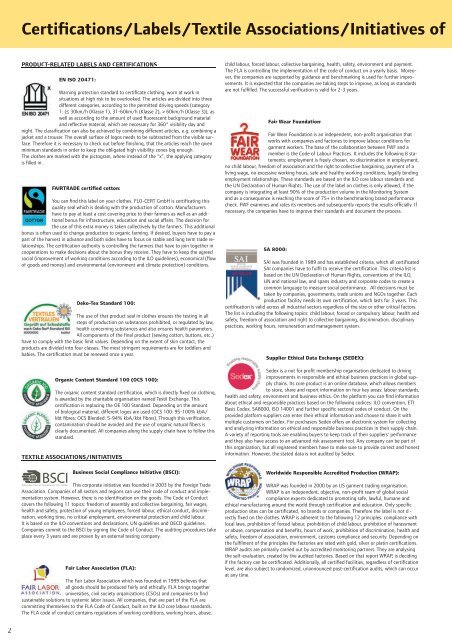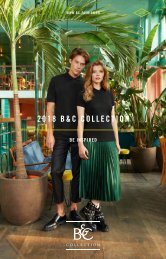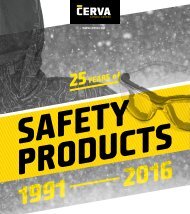Create successful ePaper yourself
Turn your PDF publications into a flip-book with our unique Google optimized e-Paper software.
Certifications/Labels/Textile Associations/Initiatives of<br />
PRODUCT-RELATED LABELS AND CERTIFICATIONS<br />
EN ISO 20471:<br />
Warning protection standard to certificate clothing, worn at work in<br />
situations at high risk to be overlooked. The articles are divided into three<br />
different categories, according to the permitted driving speeds (category<br />
1: (≤ 30km/h (Klasse 1), 31-60km/h (Klasse 2), > 60km/h (Klasse 3)), as<br />
well as according to the amount of used fluorescent background material<br />
and reflective material, which are necessary for 360° visibility day and<br />
night. The classification can also be achieved by combining different articles, e.g. combining a<br />
jacket and a trouser. The overall surface of logos needs to be subtracted from the visible surface.<br />
Therefore it is necessary to check out before finishing, that the articles reach the given<br />
minimum standards in order to keep the obligated high visibility zones big enough.<br />
The clothes are marked with the pictogram, where instead of the “x”, the applying category<br />
is filled in.<br />
FAIRTRADE certified cotton:<br />
You can find this label on your clothes. FLO-CERT GmbH is certificating this<br />
quality seal which is dealing with the production of cotton. Manufacturers<br />
have to pay at least a cost covering price to their farmers as well as an additional<br />
bonus for infrastructure, education and social affairs. The decision for<br />
the use of this extra money is taken collectively by the farmers. This additional<br />
bonus is often used to change production to organic farming. If desired, buyers have to pay a<br />
part of the harvest in advance and both sides have to focus on stable and long term trade relationships.<br />
The certification authority is controlling the farmers that have to join together in<br />
cooperations to make decisions about the bonus they receive. They have to keep the agreed<br />
social (improvement of working conditions according to the ILO guidelines), economical (flow<br />
of goods and money) and environmental (environment and climate protection) conditions.<br />
Oeko-Tex Standard 100:<br />
The use of that product seal in clothes ensures the testing in all<br />
steps of production on substances prohibited, or regulated by law,<br />
health concerning substances and also ensures health parameters.<br />
All components of the final product (sewing cotton, buttons, etc.)<br />
have to comply with the basic limit values. Depending on the extent of skin contact, the<br />
products are divided into four classes. The most stringent requirements are for toddlers and<br />
babies. The certification must be renewed once a year.<br />
Organic Content Standard 100 (OCS 100):<br />
The organic content standard certification, which is directly fixed on clothing,<br />
is awarded by the charitable organisation named Textil Exchange. This<br />
certification is replacing the OE 100 Standard. Depending on the amount<br />
of biological material, different logos are used (OCS 100: 95-100% kbA/<br />
kbt fibres; OCS Blended: 5-94% kbA/kbt fibres). Through this verification,<br />
contamination should be avoided and the use of organic natural fibers is<br />
clearly documented. All companies along the supply chain have to follow this<br />
standard.<br />
TEXTILE ASSOCIATIONS/INITIATIVES<br />
Business Social Compliance Initiative (BSCI):<br />
This corporate initiative was founded in 2003 by the Foreign Trade<br />
Association. Companies of all sectors and regions can use their code of conduct and implementation<br />
system. However, there is no identification on the goods. The Code of Conduct<br />
covers the following 11 topics: freedom of assembly and collective bargaining, fair wages,<br />
health and safety, protection of young employees, forced labour, ethical conduct, discrimination,<br />
working time, no critical employment, environmental protection and child labour.<br />
It is based on the ILO conventions and declarations, UN guidelines and OECD guidelines.<br />
Companies commit to the BSCI by signing the Code of Conduct. The auditing procedures take<br />
place every 3 years and are proven by an external testing company.<br />
Fair Labor Association (FLA):<br />
The Fair Labor Association which was founded in 1999 believes that<br />
all goods should be produced fairly and ethically. FLA brings together<br />
universities, civil society organizations (CSOs) and companies to find<br />
sustainable solutions to systemic labor issues. All companies, that are part of the FLA are<br />
committing themselves to the FLA Code of Conduct, built on the ILO core labour standards.<br />
The FLA code of conduct contains regulations of working conditions, working hours, abuse,<br />
child labour, forced labour, collective bargaining, health, safety, environment and payment.<br />
The FLA is controlling the implementation of the code of conduct on a yearly basis. Moreover,<br />
the companies are supported by guidance and benchmarking is used for further improvements.<br />
It is expected that the companies are taking steps to improve, as long as standards<br />
are not fulfilled. The successful verification is valid for 2-3 years.<br />
Fair Wear Foundation:<br />
Fair Wear Foundation is an independent, non-profit organisation that<br />
works with companies and factories to improve labour conditions for<br />
garment workers. The base of the collaboration between FWF and a<br />
member is the Code of Labour Practices. It includes the following 8 statements:<br />
employment is freely chosen, no discrimination in employment,<br />
no child labour, freedom of association and the right to collective bargaining, payment of a<br />
living wage, no excessive working hours, safe and healthy working conditions, legally binding<br />
employment relationships. These standards are based on the ILO core labour standards and<br />
the UN Declaration of Human Rights. The use of the label on clothes is only allowed, if the<br />
company is integrating at least 90% of the production volume in the Monitoring System<br />
and as a consequence is reaching the score of 75+ in the benchmarking brand performance<br />
check. FWF examines and rates its members and subsequently reports the results officially. If<br />
necessary, the companies have to improve their standards and document the process.<br />
SA 8000:<br />
SAI was founded in 1989 and has established criteria, which all certificated<br />
SAI companies have to fulfil to receive the certification. This criteria list is<br />
based on the UN Declaration of Human Rights, conventions of the ILO,<br />
UN and national law, and spans industry and corporate codes to create a<br />
common language to measure social performance. All decisions must be<br />
taken by companies, governments, trade unions and NGOs together. Each<br />
production facility needs its own certification, which lasts for 3 years. This<br />
certification is valid across all industrial sectors regardless of the size or other critical factors.<br />
The list is including the following topics: child labour, forced or compulsory labour, health and<br />
safety, freedom of association and right to collective bargaining, discrimination, disciplinary<br />
practices, working hours, remuneration and management system.<br />
Supplier Ethical Data Exchange (SEDEX):<br />
Sedex is a not for profit membership organisation dedicated to driving<br />
improvements in responsible and ethical business practices in global supply<br />
chains. Its core product is an online database, which allows members<br />
to store, share and report information on four key areas: labour standards,<br />
health and safety, environment and business ethics. On the platform you can find information<br />
about ethical and responsible practices based on the following codices: ILO convention, ETI<br />
Basis Codex, SA8000, ISO 14001 and further specific sectoral codes of conduct. On the<br />
provided platform suppliers can enter their ethical information and choose to share it with<br />
multiple customers on Sedex. For purchasers Sedex offers an electronic system for collecting<br />
and analyzing information on ethical and responsible business practices in their supply chain.<br />
A variety of reporting tools are enabling buyers to keep track of their suppliers’ performance<br />
and they also have access to an advanced risk assessment tool. Any company can be part of<br />
this organization, but all registered members have to make sure to provide correct and honest<br />
information. However, the stated data is not audited by Sedex.<br />
Worldwide Responsible Accredited Production (WRAP):<br />
WRAP was founded in 2000 by an US garment trading organisation.<br />
WRAP is an independent, objective, non-profit team of global social<br />
compliance experts dedicated to promoting safe, lawful, humane and<br />
ethical manufacturing around the world through certification and education. Only specific<br />
production sites can be certificated, no brands or companies. Therefore the label is not directly<br />
fixed on the clothes. WRAP is adherent to the following 12 principles: compliance with<br />
local laws, prohibition of forced labour, prohibition of child labour, prohibition of harassment<br />
or abuse, compensation and benefits, hours of work, prohibition of discrimination, health and<br />
safety, freedom of association, environment, customs compliance and security. Depending on<br />
the fulfilment of the principles the factories are rated with gold, silver or platin certifications.<br />
WRAP audits are primarily carried out by accredited monitoring partners. They are analysing<br />
the self-evaluation, created by the audited factories. Based on that report WRAP, is deciding<br />
if the factory can be certificated. Additionally, all certified facilities, regardless of certification<br />
level, are also subject to randomized, unannounced post-certification audits, which can occur<br />
at any time.<br />
2








